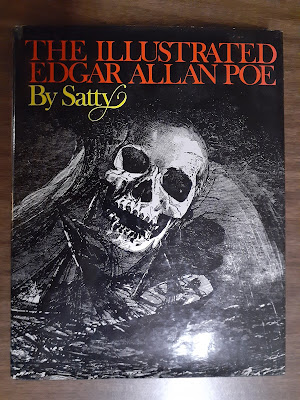 |
| Photo Credit: the blogger. Book and Illustration Credit: Wilfried Satty. |
Last Thursday January 19th was the 214th birthday of Edgar Allan Poe, the Father of American horror fiction. To celebrate, I thought it would be neat to do a book review but not of one of his short stories. Instead, I want to review a collection of them, but not one that was put together by publishers or editors of Poe’s time. The book that I want to review here wasn’t even put together by an editor after his time. It was put together in the 1970s by an artist. Wilfried Satty was a collage artist, who selected several of Poe’s stories and made the illustrations for them in the book, "The Illustrated Edgar Allan Poe". Satty's art in this collection enhances the nightmarish situations of the stories.
Published in 1976 by Clarkson N. Potter, Satty’s “Illustrated Edgar Allan Poe” opens with a very informative introduction by “San Francisco Chronicle” art critic Thomas Albright. The hardcopy I own has a nice jacket with an illustration from one of the stories, "MS. Found in a Bottle", depicting a giant skull hovering over a ship being tossed in a storm. “Bottle” is the first of 14 works in this book. Some of the other stories are "The Fall of the House of Usher," "The Murders in the Rue Morgue," "The Pit and the Pendulum", and even some of Poe's lesser known ones such as Metzengerstein. There are also two poems: “Dream-land” and "Alone".
All 80 illustrations in the book are in black and white bringing out the theme of contrasting lightness and darkness which is characteristic of gothic horror. According to the official website of the artist, some of these are made from 19th century woodcut images. Most of the illustrations--many of which are collages--are surreal, very detailed and complex. The surrealism goes really good with the stories since many of Poe's tales have been open for surreal interpretation. An example is "The Fall of the House of Usher" with the black tarn that mirrors the mansion. Satty makes an excellent illustration of this in the “Haunted Palace” poem segment of the story. You almost can’t tell the reflection from the object itself.
What really captures the reader is the abyssmal imagery seen throughout the book. This is especially in illustrations to stories such as the seafaring ones, like “MS. found in a Bottle” and "A Descent into the Maelstrom", where violent oceans open up into yawning black chasms intensifying the horror.
Satty’s psychologically disturbing yet fascinating images add to the atmosphere of supernatural horror and mystery in the stories collected in "The Illustrated Edgar Allan Poe". Even if you don't pick up a copy of the book for the stories themselves, the illustrations alone are worth it! Unfortunately, its' hard to find this book today. I purchased my copy, used, several years ago at a science fiction/fantasy convention. However, there are a few online sources that may carry the book such as Abe Books and Amazon. Sadly, the artist died in 1982, much too early like Poe, and so his work stopped there. But you can see some of it at the official website.
Newsletter
I don't think I will be able to get to putting out a newsletter for this month. So, there will be one next month. If you haven't signed up for a free subscription, you can do so here. If you decide not to sign up now, you can always do so at the new Author's Newsletter page which just went live Friday! It can be found at the top of the page here at A Far Out Fantastic Site. Because “Night Creatures’ Call” is my author's newsletter, in each issue you'll get the latest updates on my current fiction projects, such as my short story collection "Bad Apps", among many other things related to science fiction, horror and fantasy.
Do you have a favourite illustrator of fiction? Do you celebrate Edgar Allan Poe's birthday and if so how?
Until next time . . .
Black and white illustrations would be perfect for his stories. Clever to put a book together with artwork.
ReplyDeleteIt's really neat. I'm surprised there aren't more books like that out there.
Delete